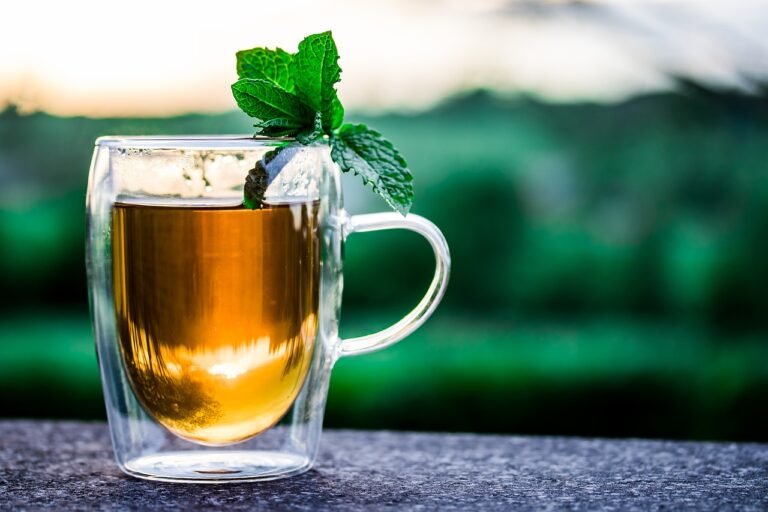How to Make Lemon Balm Tea: Expert Tips You Didn’t Know for the Perfect Brew!
Lemon balm tea is a delightful herbal brew that’s both flavorful and packed with incredible benefits like easing anxiety, improving sleep, and boosting digestive health.
Lemon balm is your new secret weapon for relaxation. Its subtle lemony aroma brings calmness and helps whisk away stress. Did you know it’s also rich in antioxidants?
In this post, we’ll uncover the benefits of lemon balm, provide an easy lemon balm tea recipe and essential herbal tea brewing tips. Plus, we’ll explore the fascinating lemon balm tea properties and how it can transform your sleep routine.
If you’re ready to dive deeper into herbal healing, don’t miss our related post on other Herbal Tea Health Benefits or check out our recommended lemon balm tea brands for a quality brew every time.

Lemon Balm Tea Benefits
Relief from Anxiety and Stress
Lemon balm tea has been used for centuries as a calming remedy. Its natural compounds interact with your body to help ease those gnawing worries. Now, I’m not saying it’s a magic potion, but it’s a touch of serenity in a cup. According to a study published in the Journal of Phytotherapy Research, lemon balm has shown efficacy in reducing stress and anxiety symptoms. [Source: NCBI]
Improved Sleep Quality
Tossing and turning is no fun. I know because I’ve been there. Lemon balm tea is a gentle nudge into dreamland. The aromatic leaves contain natural compounds that help relax muscles and nerves. It’s as if the leaves whisper, “You’ve got this, rest now.” Here is the lemon balm tea that I resort to during sleepless nights.

-Promotes a good night’s sleep with the extra power of valerian.*
-Non-GMO verified. All Ingredients Certified Organic. Kosher. Caffeine Free.
-Consistently high quality herbs from ethical trading partnerships.
-Taste: Earthy, minty and satisfyingly herbal.*
Boosting Digestive Health
If your stomach’s been a bit iffy lately, lemon balm might be your remedy. I’ve often turned to this herb when my tummy’s rumbling in protest. It soothes and balances your insides. When you sip, it seems to tell your achy belly, “Calm down, buddy, help is on the way.” Integrative Medicine reports that lemon balm can significantly improve various gastrointestinal symptoms. [Source: NCBI]
Rich in Antioxidants
We all need protection from those pesky free radicals, right? Well, lemon balm’s rich array of antioxidants help ward off those rogue cells with resilience. It’s a tiny shield protecting your body’s cells, fighting the good fight every time you drink a cup.

Consistently high quality herbs from ethical trading partnerships; USDA Certified Organic. Non-GMO Verified. Kosher. Caffeine Free. Certified B Corp.
Lemon Balm Tea Recipe
Ingredients Needed
The beauty of this tea is its simplicity. You’ll need water, fresh or dried lemon balm leaves, a dash of love, and optionally, a slice or two of lemon or a bit of honey for that sweet touch. Simple ingredients, maximum goodness. I like this highly rated and popular lemon balm leaf from amazon.

100% fresh all natural bulk lemon balm herbal tea from the unblemished Balkan countryside.
Preparation Steps
Start with gathering your ingredients. Bring water to a gentle simmer—not a wild boil. That’s too aggressive for those delicate leaves. Add the lemon balm leaves—about a tablespoon if dried, or a handful if fresh. Turn off the heat and let them soak in the warm bath for about 10 minutes.
Brewing Recommendations
My grandmother taught me there’s a sweet spot—10 minutes of steeping is usually just perfect. Too short, and you miss the soothing symphony of flavors. Too long, and bitterness births its ugly head. Keep it gentle and let the leaves work their magic.
Herbal Tea Brewing Tips
1. Choosing Fresh vs. Dried Leaves
Both have their virtues. Fresh leaves, with their bright fragrance, are like springtime in a cup. Dried leaves, gently coaxed under the sun, carry a deeper, more concentrated essence. I switch between the two depending on what’s available in my garden or pantry.
2. Optimal Water Temperature
A gentle simmer—around 190°F—is your friend here. Too hot, and the leaves lose their delicate oils and flavors. Maintain a steady hand and avoid a boiling rampage.
3. Steeping Time Considerations
Your patience will be rewarded. Aim for 10 minutes. But remember, taste is personal. If it feels too mild, steep a little longer next time. Find your goldilocks zone.
4. Enhancing Flavor with Additional Ingredients
I love experimenting. A touch of honey or a sprig of mint can elevate your tea. Once, I even added a cinnamon stick. Get creative and let your palate guide you.
Brew Lemon Balm Tea
Using Fresh Lemon Balm
Fresh from the garden, those vibrant green leaves eagerly await the water’s embrace. Crush them a little in your hands first to release their citrusy fragrance.
Using Dried Lemon Balm Leaves
Dried leaves require just a handful or a tablespoon for an average pot. They’ve been blessed by the sun’s warmth and are ready to deliver their robust essence to your cup.
Adjusting Strength and Flavors
One size doesn’t fit all here. If you want it stronger, add more leaves. Too strong? Balance with extra water. Your tea, your rules. I often adjust based on my mood. Some days call for boldness, other days for subtlety.
Lemon Balm Tea Properties
Lemon balm teems with rosmarinic acid, known for its calming effects. Combine this with essential oils and you get a power-punch of goodness.
Lemon balm tea has a gentle citrus undertone mingling with soft mint.
There’s more to lemon balm than meets the eye. Regular consumption can support cognitive function and stability to aid memory and concentration. It’s a holistic booster for both mind and body. You will be glad to have it in your pantry!
Sources:





